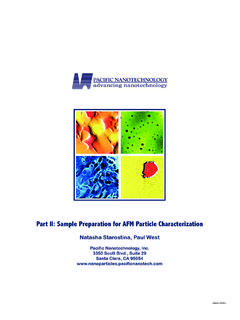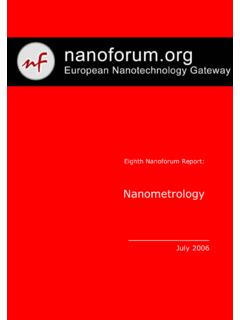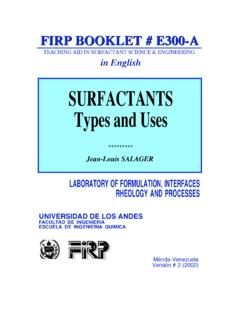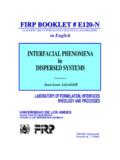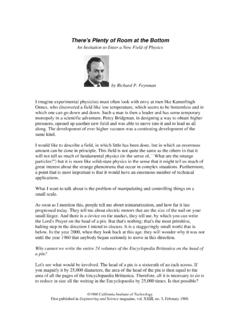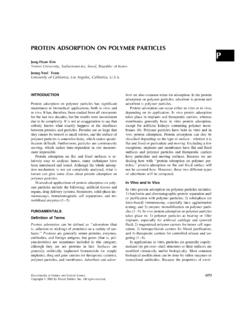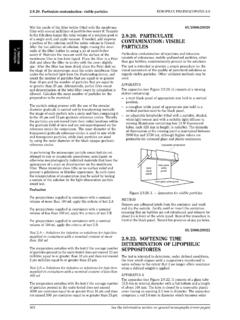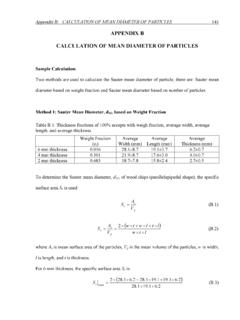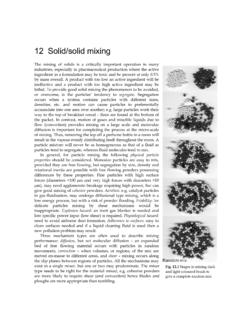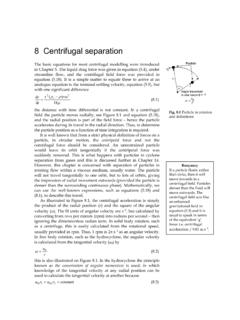Transcription of Ellipsoidal Hybrid Magnetic Microgel Particles with ...
1 12. July 2011. Ellipsoidal Hybrid Magnetic Microgel Particles with Thermally Tunable Aspect Ratios Herv Dietsch, Particles 2011 Conference 9-12 July 2011. Adolphe Merkle Institute Universit de Fribourg T +41 26 300 91 37 Rte de l Ancienne Papeterie 3 F +41 26 300 97 47 CH-1723 Marly Functionalized Building Blocks: Colloids, Polymers, Surfactants Particles 2011 conference Building Blocks Interactions, Phase Behavior, Stimuli-Responsive Particles Microstructure Temperature, Soft Magnetic field, Materials Light, pH, Structures Properties Molecule to be detected, Protein . and Particle Assemblies Nanostructured Materials Crystallization, Particle-particle interactions -> Novel Properties: Phase Particle-solvent interactions Separation, Eventually as a function of Gelation the used stimulus I 12. July 2011 I p. 2. Thermoresponsive Particles : LCST and VPTT.
2 Microscopic scale Example: PNIPAM a thermosensitive polymer Microgel behavior Linear chain Microgel good solvent Tc 33 C poor solvent (network) => swollen => collapsed hard sphere soft shell T<LCST T>LCST H2O. H2O. LCSTPNIPAM~33 C. Low Critical Solution Temperature VPTT. Volume Phase Transition Temperature I 12. July 2011 I p. 3. Thermoresponsive Particles : LCST and VPTT. Microscopic scale Example: PNIPAM a thermosensitive polymer Size, volume fraction Microgel behavior Linear chain Microgel Tc 33 C. and good solvent poor solvent (network) => swollen => collapsed Interactions control soft shell hard sphere One single trigger: Temperature T<LCST T>LCST H2O. H2O. LCSTPNIPAM~33 C. Low Critical Solution Temperature VPTT. Volume Phase Transition Temperature I 12. July 2011 I p. 4. Another Stimulus and morphology: a Ellipsoidal -shaped Magnetic Particles Submicrosized 80nm<a<150nm 3.
3 Without phosphate ions 6. Isotropic particle Matijevic et. al. 1978 Oca a et. al. 1999. I 12. July 2011 I p. 5. Alternative: Tuning the aspect ratio by silica coating TEOS. in H2O in Ethanol NH3. I 12. July 2011 I p. 6 Based on Graf et. al. 2003. Alternative: Tuning the aspect ratio by silica coating TEOS. in H2O in Ethanol NH3. I 12. July 2011 I p. 7 Based on Graf et. al. 2003. Morphology characterization using SAXS and TEM. uncoated 13 nm silica 30 nm silica 59 nm silica M. Reufer, HD et al., J. Phys. Chem. B, 2010, 114, 4763 4769. I 12. July More about I p. 8. 2011 Magnetic properties: M. Reufer, HD et al., J Phys. Cond. Matter, 2011, 23,065102. Control of the surface chemistry thanks to the silica layer R'. R'. O O R'. S i OH silane agent S i O. S i HO OH O O O O. R'. S i O O S i HO OH R'. R'. O O. O O. O. HO OH R S i S i OH S i R Si R' O O.
4 R'. R O R'. + H-R. H3C O. CH2. H3C Si O. O. O CH3 CH3. silane agent Surface modification I 12. July 2011 I p. 9. Hybrid combination with the thermoresponsive PNIPAM shell Monomer, cross-linker, initiator, . Precipitation Reactive silane on polymerization the surface H2C. O. HN. CH3. H3C. NIPAM. -Fe2O3/PNIPAM. C. Dagallier, I 12. July Dietsch*, I p. 10 P. Schurtenberger and F. Scheffold, Soft Matter, 2010, 6(10): 2174-2177. Temperature response and dynamical arrest DLS. 550 Rb2. 120. 500. Rb1. 450. 100. [nm]. RRh [nm]. 400. 80 V. 350. Rh NaSCN Ra 300. 60 Rh T 15 C Rb1. 250. 40. 200 . 15 15 20 20 25 25 30 30 35 35 40 40 45. TT [ C]. [ C]. Hydrodynamic Hydrodynamic radius radius of of hematite-PNIPAM. PNiPAM Microgel core-shell vs. Particles vs. temperature. temperature. V. Rb1>Rb2>Ra 30 C Rb2. I 12. July 2011 I p. 11. Probing the rotation of Hybrid microgels Pre-alignment Setup Direction of Light beam (Microscope).
5 35 C.. 35 C. B . B .. B 10 C. 10 C. birefringent CCD. P P. Experiment: temperature ramp A A.. H. I 12. July 2011 I p. 12. Probing the rotation of Hybrid microgels Pre-alignment Setup Direction of Light beam (Microscope). 35 C.. 35 C. B . B .. B 10 C. 10 C. birefringent CCD. P P. Experiment: temperature ramp A A.. H. I 12. July 2011 I p. 13. Properties of the Hybrid microgels PNIPAM microgels Hematite Particles C. Dagallier, I 12. July Dietsch*, I p. 14 P. Schurtenberger and F. Scheffold, Soft Matter, 2010, 6(10): 2174-2177. Properties of the Hybrid microgels Size, volume fraction, Interactions control, Optical anisotropy, Magnetic orientation control PNIPAM microgels Two triggers: Temperature and Magnetic field Hematite Particles C. Dagallier, I 12. July Dietsch*, I p. 15 P. Schurtenberger and F. Scheffold, Soft Matter, 2010, 6(10): 2174-2177.
6 Remaining challenges Increase the Magnetic response Hematite are canted-antiferromagnetic Orientation under Magnetic field along the long axis .. y . H y . H. x z Morphology changes with temperature T. I 12. July 2011 I p. 16. Conclusion Particles with a proper surface chemistry can be incorporated in a Microgel (or another polymer shell or bulk) if used as seeds. Magnetic responsive can be tailored by control of the crystalline structure Combining two stimuli can lead to more than 2 new properties ( Magnetic and thermosensitive can lead also to morphology mutation and polarization of light, X- ray ). Can be used for rotation diffusion, friction, glass transition, phase diagrams, orientationna relaxation in dense Microgel suspensions, active microrheology studies . I 12. July 2011 I p. 17. The Group Liliane Ackermann Adriana Mihut Shuo Bai Camille Dagallier (Stanford).
7 Verena Staedele (PSI). Ann Hirt (ETHZ). Urs Gasser (PSI). Stefan Hengsberger(EIF). Frank Scheffold (UniFr). Peter Schurtenberger (ULund). Funding Izabela Bobowska Olivier Pravaz J r me Crassous I 12. July 2011 I p. 18.
